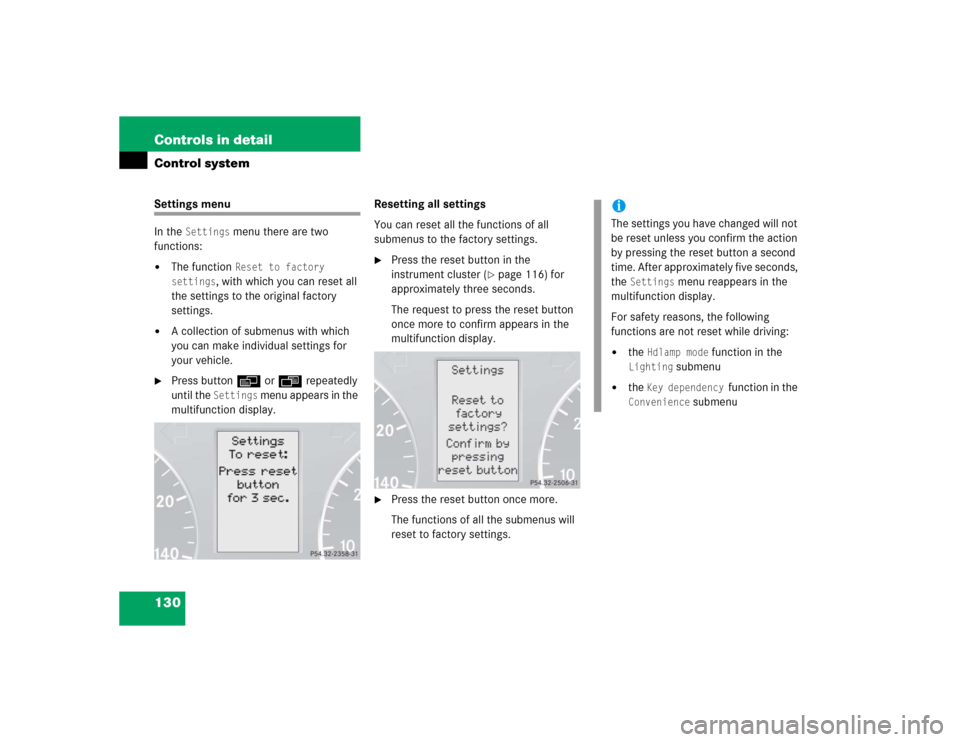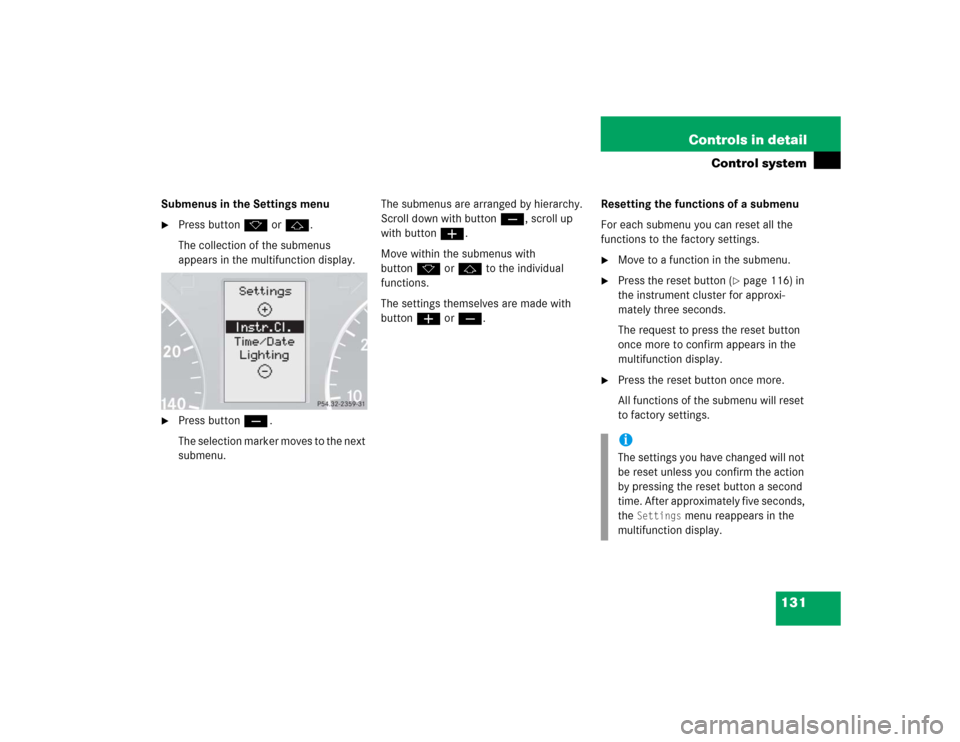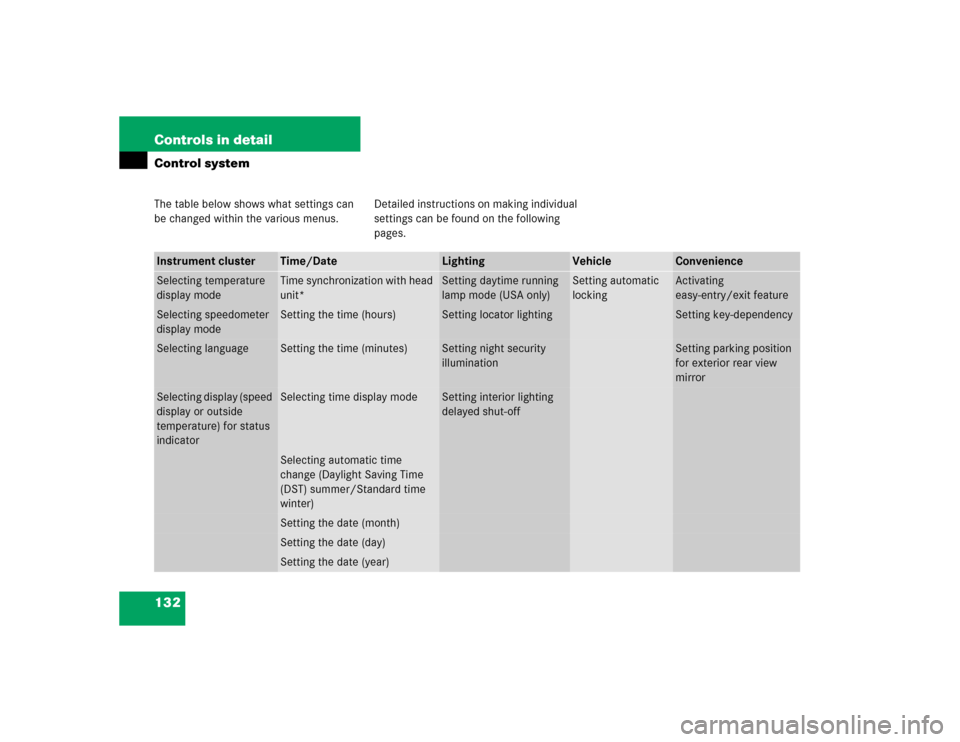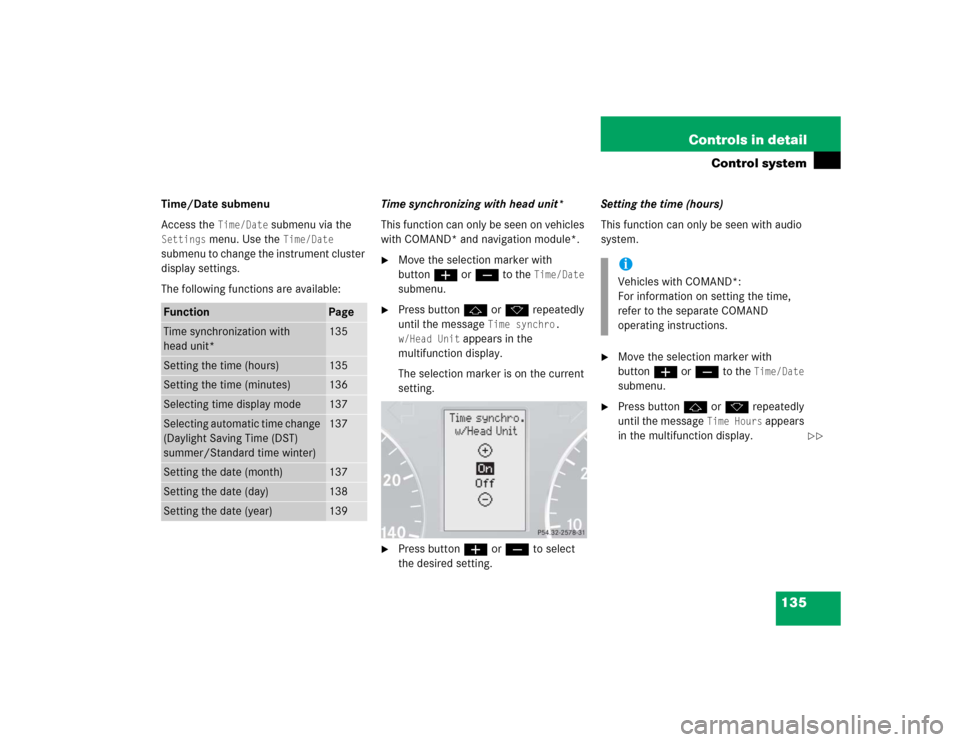Page 52 of 426
50 Getting startedDriving�
Push combination switch in direction of
arrow1.
The high beam headlamp indicator
lampA in the instrument cluster
comes on (
�page 24).
Turn signals
The combination switch is located on the
left of the steering column.Combination switch1Turn signals, right
2Turn signals, left
�
Press combination switch in direction
of arrow1 or2.
The corresponding turn signal indicator
lampL orK in the instrument
cluster flashes (
�page 24).
The combination switch resets automati-
cally after major steering wheel move-
ments.
Windshield wipers
The combination switch is located on the
left of the steering column.Combination switch1Single wipe
2Switching on windshield wipers�
Switch on ignition (
�page 33).
iTo signal minor directional changes
such as changing lanes, press combi-
nation switch only to point of resis-
tance and release. The corresponding
turn signals will flash three times.
Page 66 of 426

64 Safety and SecurityOccupant safety
Safety guidelines for the seat belt,
emergency tensioning device and
air bag In cases of other frontal impacts,
angled impacts, roll-overs, other side
impacts, rear collisions, or other acci-
dents, the air bags will not be activat-
ed. The driver and passengers will then
be protected by the fastened seat
belts.
We caution you not to rely on the
presence of the air bags in order to
avoid wearing your seat belt.
Your vehicle was originally equipped
with air bags that are designed to acti-
vate in certain impacts exceeding a
preset threshold to reduce the poten-
tial and severity of injury. It is important
to your safety and that of your passen-
gers that you replace deployed air bags
and repair any malfunctioning air bags
to make sure that the vehicle will con-
tinue to provide supplemental crash
protection for occupants.Warning!
G
�
Damaged seat belts or belts that were
highly stressed in an accident must be
replaced and their anchoring points
must also be checked. Only use belts in-
stalled or supplied by an authorized
Mercedes-Benz Center.
�
Air bags and emergency tensioning
devices (ETDs) are designed to function
on a one-time only basis. An air bag or
ETD that was activated must be
replaced.
�
No modifications of any kind may be
made to any components or wiring of
the SRS. This includes changing or re-
moving any component or part of the
SRS, the installation of additional trim
material, badges, etc. over the steering
wheel hub, passenger front air bag
cover, door trim panels, or door frame
trims, and installation of additional elec-
trical/electronic equipment on or near
SRS components and wiring. Keep area
between air bags and occupants free
from objects (e.g. packages, purses,
umbrellas, etc.).
�
Do not pass belts over sharp edges.
They could tear.
�
Do not make any modification that could
change the effectiveness of the belts.
�
Do not bleach or dye seat belts as this
may severely weaken them. In a crash
they may not be able to provide ade-
quate protection.
Page 129 of 426
127 Controls in detail
Control system
�
Press buttonk orj repeatedly
until the desired channel is found.Operate the CD player*
�
Turn on the radio and select the CD
player (
�page 193).
Vehicles with COMAND*:
Refer to separate operating
instructions.
�
Press buttonè orÿ repeatedly
until the settings for the CD currently
being played appear in the
multifunction display.
1Current CD (for CD changer*)
2Current track
�
Press buttonk orj repeatedly
until the desired track is selected.
iFeature description is based on
preliminary information available at
time of printing.
For more information on satellite radio
operation, see “Introduction to satellite
radio* (USA only)” (
�page 188).
Vehicles with COMAND*:
Refer to separate operating
instructions.
iTo select a CD from the magazine,
press a number on the audio system or
the COMAND* system key pad located
in the center dashboard.
Page 132 of 426

130 Controls in detailControl systemSettings menu
In the
Settings
menu there are two
functions:
�
The function
Reset to factory
settings
, with which you can reset all
the settings to the original factory
settings.
�
A collection of submenus with which
you can make individual settings for
your vehicle.
�
Press buttonè orÿ repeatedly
until the
Settings
m e n u a p p e a r s i n t h e
multifunction display.Resetting all settings
You can reset all the functions of all
submenus to the factory settings.
�
Press the reset button in the
instrument cluster (
�page 116) for
approximately three seconds.
The request to press the reset button
once more to confirm appears in the
multifunction display.
�
Press the reset button once more.
The functions of all the submenus will
reset to factory settings.
iThe settings you have changed will not
be reset unless you confirm the action
by pressing the reset button a second
time. After approximately five seconds,
the
Settings
menu reappears in the
multifunction display.
For safety reasons, the following
functions are not reset while driving:
�
the
Hdlamp mode
function in the
Lighting
submenu
�
the
Key dependency
function in the
Convenience
submenu
Page 133 of 426

131 Controls in detail
Control system
Submenus in the Settings menu�
Press buttonk orj.
The collection of the submenus
appears in the multifunction display.
�
Press buttonç.
The selection marker moves to the next
submenu.The submenus are arranged by hierarchy.
Scroll down with buttonç, scroll up
with buttonæ.
Move within the submenus with
buttonk orj to the individual
functions.
The settings themselves are made with
buttonæ orç.Resetting the functions of a submenu
For each submenu you can reset all the
functions to the factory settings.
�
Move to a function in the submenu.
�
Press the reset button (
�page 116) in
the instrument cluster for approxi-
mately three seconds.
The request to press the reset button
once more to confirm appears in the
multifunction display.
�
Press the reset button once more.
All functions of the submenu will reset
to factory settings.iThe settings you have changed will not
be reset unless you confirm the action
by pressing the reset button a second
time. After approximately five seconds,
the
Settings
menu reappears in the
multifunction display.
Page 134 of 426

132 Controls in detailControl systemThe table below shows what settings can
be changed within the various menus. Detailed instructions on making individual
settings can be found on the following
pages.Instrument cluster
Time/Date
Lighting
Vehicle
Convenience
Selecting temperature
display mode
Time synchronization with head
unit*
Setting daytime running
lamp mode (USA only)
Setting automatic
locking
Activating
easy-entry/exit feature
Selecting speedometer
display mode
Setting the time (hours)
Setting locator lighting
Setting key-dependency
Selecting language
Setting the time (minutes)
Setting night security
illumination
Setting parking position
for exterior rear view
mirror
Selecting display (speed
display or outside
temperature) for status
indicator
Selecting time display mode
Setting interior lighting
delayed shut-off
Selecting automatic time
change (Daylight Saving Time
(DST) summer/Standard time
winter)Setting the date (month)Setting the date (day)Setting the date (year)
Page 137 of 426

135 Controls in detail
Control system
Time/Date submenu
Access the
Time/Date
submenu via the
Settings
menu. Use the
Time/Date
submenu to change the instrument cluster
display settings.
The following functions are available:Time synchronizing with head unit*
This function can only be seen on vehicles
with COMAND* and navigation module*.
�
Move the selection marker with
buttonæ orç to the
Time/Date
submenu.
�
Press buttonj ork repeatedly
until the message
Time synchro.
w/Head Unit
appears in the
multifunction display.
The selection marker is on the current
setting.
�
Press buttonæ orç to select
the desired setting.Setting the time (hours)
This function can only be seen with audio
system.
�
Move the selection marker with
buttonæ orç to the
Time/Date
submenu.
�
Press buttonj ork repeatedly
until the message
Time Hours
appears
in the multifunction display.
Function
Page
Time synchronization with
head unit*
135
Setting the time (hours)
135
Setting the time (minutes)
136
Selecting time display mode
137
Selecting automatic time change
(Daylight Saving Time (DST)
summer/Standard time winter)
137
Setting the date (month)
137
Setting the date (day)
138
Setting the date (year)
139
iVehicles with COMAND*:
For information on setting the time,
refer to the separate COMAND
operating instructions.
��
Page 139 of 426

137 Controls in detail
Control system
Selecting time display mode�
Move the selection marker with
buttonæ orç to the
Time/Date
submenu.
�
Press buttonj ork repeatedly
until the message
Clock display
appears in the multifunction display.
The selection marker is on the current
setting.
�
Press buttonæ orç to set
the
12h
or
24h
time display mode.Selecting automatic time change
(Daylight Saving Time (DST)
summer/Standard time winter)
�
Move the selection marker with
buttonæ orç to the
Time/Date
submenu.
�
Press buttonj ork repeatedly
until the message
Change-over
Summer / Winter time
appears in the
multifunction display.
The selection marker is on the current
setting.
�
Press buttonæ orç to select if
the changeover between summer and
winter time should be automatic or
manual.
Setting the date (month)
This function can only be seen with audio
system.
�
Move the selection marker with
buttonæ orç to the
Time/Date
submenu.
�
Press buttonj ork repeatedly
until the message
Date Set MM
appears
in the multifunction display.
iVehicles with COMAND*:
For information on setting the date,
refer to the separate COMAND
operating instructions.
��